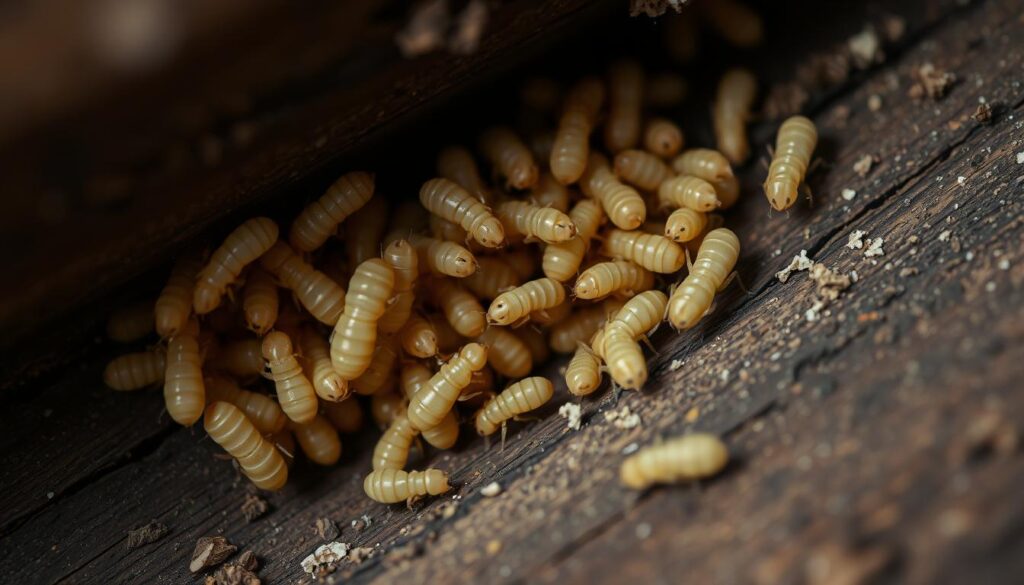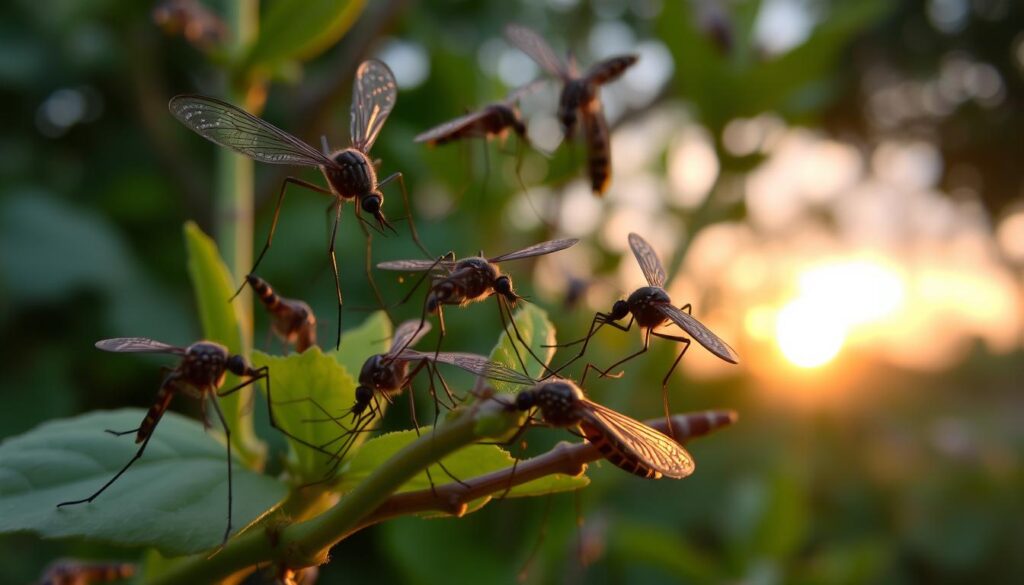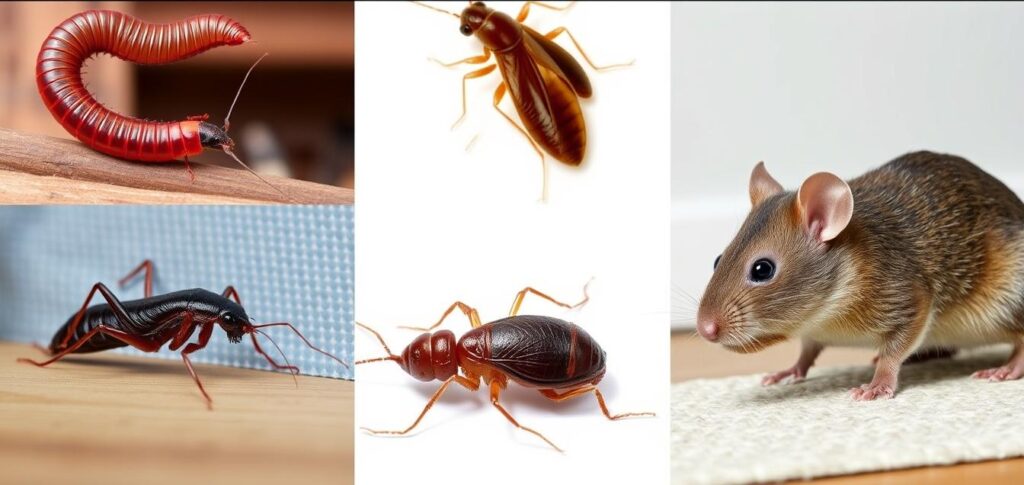Living in Hampton Roads has its benefits, but it also comes with pests. Knowing how to identify pests is key to a safe and comfy home. From small ants to big rodents, pests in Hampton Roads can be a big problem. This guide will show you how to spot pests before they cause trouble.
It’s important to know about pests in your area. Hampton Roads’ weather and land make it a perfect place for many pests. By learning to spot pests early, you can fight infestations better.
Understanding Common Pests Hampton Roads Residents Face Daily
Living in Hampton Roads means dealing with a unique pest ecology. The coastal Virginia climate is perfect for pests to thrive. Let’s explore the pest patterns you might encounter and why certain species find this area so inviting.
Seasonal Pest Patterns in Coastal Virginia
Hampton Roads experiences distinct seasons, each bringing its own set of pest challenges. Spring welcomes ants and termites. Summer sees an influx of mosquitoes and flies.
Fall brings rodents seeking shelter, and winter doesn’t mean you’re off the hook – some pests remain active year-round.
Impact of Local Climate on Pest Activity
The climate impact on pests in Hampton Roads is significant. Warm, humid summers create ideal breeding conditions for mosquitoes and cockroaches. Mild winters allow many pests to remain active longer than in colder regions.
This unique climate pattern contributes to the area’s diverse and persistent pest population.
Why Hampton Roads Attracts Specific Pest Species
Hampton Roads’ geography plays a crucial role in attracting specific pests. The mix of urban areas, wetlands, and woodlands provides varied habitats. Termites thrive in the moist soil, while rats and mice find ample hiding spots in human structures.
The abundance of water sources attracts mosquitoes, making them a common nuisance for residents.
“Understanding the local pest ecology is key to effective prevention and control in Hampton Roads.”
By recognizing these patterns, you can better prepare for and manage pest issues in your home throughout the year. Stay vigilant and consider professional pest control services to keep your living space pest-free in this unique coastal Virginia environment.
Signs of Ant Infestations in Your Home
Spotting ant infestation signs early can save you from a full-blown invasion. Hampton Roads residents often face household ants. Knowing what to look for is key to effective ant control.
- Ant trails: Long lines of ants marching in or out of your home
- Mounds: Small piles of soil near foundations or in your yard
- Wood shavings: Tiny piles near wooden structures indicate carpenter ants
- Food contamination: Ants in pantries or around pet food bowls
Different ant species in Hampton Roads have unique characteristics. Here’s a quick guide:
| Ant Type | Color | Size | Preferred Food |
|---|---|---|---|
| Odorous House Ants | Dark brown to black | 1/16 to 1/8 inch | Sweets, meats |
| Pavement Ants | Dark brown to black | 1/8 inch | Greasy foods, seeds |
| Carpenter Ants | Black or red and black | 1/4 to 1/2 inch | Sweets, proteins |
If you spot these signs, it’s time to consider professional ant control. Hampton Roads pest experts can identify the specific ant species. They can then implement targeted solutions to protect your home.
Identifying and Dealing with Cockroach Problems
Knowing how to identify cockroaches is key to keeping your home pest-free in Hampton Roads. These pests can quickly become a problem if not dealt with. Let’s look at the two main types you might find: German cockroaches and American cockroaches.
German Cockroach Identification
German cockroaches are small, about 1/2 to 5/8 inches long. They have light brown bodies with two dark stripes on their backs. These pests breed fast and like warm, moist places like kitchens and bathrooms.
American Cockroach Characteristics
American cockroaches are bigger, up to 2 inches long. They have reddish-brown bodies and a yellowish figure-eight pattern on their heads. These cockroaches often live in basements, crawl spaces, and sewers.
Common Hiding Spots and Entry Points
Both German and American cockroaches like dark, warm spots. Look for them in:
- Cracks and crevices in walls
- Behind appliances
- Under sinks
- In cardboard boxes
Cockroaches can get into your home through tiny openings around pipes, windows, and doors. Seal these spots to stop them from getting in. If you see cockroaches, act fast to solve the problem and keep your home clean and pest-free.
Rodent Detection and Recognition Guide
Spotting signs of rodent activity is key for Hampton Roads homeowners. Mice and rats can quickly become a big problem if ignored. This guide will help you spot these unwanted guests and act fast.
Identifying rodents starts with their signs. Look for small, dark droppings near food or walls. You might see gnaw marks on wood, wires, or food. Grease marks on baseboards show where rodents travel.
Mouse infestations have smaller droppings and less damage. Rats leave bigger droppings and more visible gnaw marks. Both can fit through tiny openings, so check for gaps around pipes and vents.
| Sign | Mouse | Rat |
|---|---|---|
| Droppings | Rice-sized, pointed ends | Olive-sized, blunt ends |
| Footprints | Small, four-toed front, five-toed back | Large, four-toed front, five-toed back |
| Gnaw marks | 1/8 inch in diameter | 1/4 inch in diameter |
| Entry holes | Dime-sized | Quarter-sized |
If you think you have rodents in your Hampton Roads home, act fast. Seal holes, remove food, and consider traps. For big problems, get help from a pest control service to solve rat issues and stop future problems.
Spider Species Common to Hampton Roads
Hampton Roads has many spider species. Most are safe, but knowing the dangerous ones is key to staying safe. Let’s look at the spiders you might find in your home and yard.
Harmless House Spiders vs. Dangerous Species
Most spiders in Hampton Roads are safe and help control pests. Spiders like cellar spiders and jumping spiders are not a threat. But, watch out for black widow and brown recluse spiders. They can bite and cause harm.
Web Patterns and Their Meanings
Knowing spider webs can tell you which spiders are around. Orb weavers make round webs. Funnel weavers create sheet-like webs with a hidden spot. Cobweb spiders build messy webs in corners.
| Web Type | Spider Species | Location |
|---|---|---|
| Orb | Garden Spider | Outdoors, between plants |
| Funnel | Grass Spider | Low vegetation, ground level |
| Cobweb | Common House Spider | Indoor corners, under furniture |
Seasonal Spider Activity
Spider activity changes with the seasons in Hampton Roads. You’ll see more spiders inside during fall as they seek warmth. Spring brings more outdoor webs as food is plentiful. Always be ready to manage spider numbers all year.
Termite Warning Signs and Identification

Termites are a big threat to homes in Hampton Roads. Spotting termite signs early can save you from expensive fixes. Let’s look at how to find these pests and keep your home safe.
Mud tubes are a clear sign of termites. These thin paths show up on walls or wood. Termites use them to get to food. Seeing these tubes means it’s time to call for help.
Wood damage is another sign of termites in Hampton Roads. Wood that sounds hollow or looks blistered is a clue. Termites eat wood from the inside, making it hard to see damage until it’s big.
In spring, look out for swarmers. These are winged termites looking to start new colonies. They might look like flying ants. Seeing them near your home means termites are around.
| Sign | Description | Action |
|---|---|---|
| Mud tubes | Pencil-thin tunnels on walls or wood | Contact pest control immediately |
| Wood damage | Hollow-sounding or blistered wood | Inspect thoroughly, seek professional help |
| Swarmers | Winged termites, often near light sources | Schedule a termite inspection |
Early detection is crucial in fighting termites. Regular checks can catch signs before damage gets bad. If you think you have termites, call a pest control expert who knows Hampton Roads termites.
Bed Bug Detection Methods
Bed bug detection is key for Hampton Roads homeowners. These pests hide in tiny cracks, so spotting them early is crucial. Let’s look at the signs of bed bugs and how to find them in your home.
Physical Signs of Bed Bugs
Spotting bed bug signs is the first step. Look for these signs:
- Rusty or reddish stains on bed sheets or mattresses
- Dark spots about the size of a period
- Eggs and eggshells, which are tiny and pale yellow
- Live bed bugs
Common Hiding Places
Bed bugs are experts at hiding. They often hide in:
- Mattress seams and box springs
- Bed frames and headboards
- Furniture joints
- Electrical outlets
- Behind wallpaper or picture frames
How to Inspect Your Furniture
Inspecting your furniture is crucial for bed bug detection. Use a flashlight and magnifying glass to check seams, tufts, and crevices. Focus on your mattress, box spring, and bed frame. Also, check nearby furniture and curtains.
| Inspection Area | What to Look For |
|---|---|
| Mattress Seams | Dark spots, live bugs, shed skins |
| Box Spring | Bugs hiding in corners and joints |
| Furniture Joints | Eggs, fecal matter, live bugs |
| Electrical Outlets | Bugs seeking warmth and shelter |
Early detection is vital. If you find bed bug signs, call a pest control pro right away. Regular checks can stop an infestation in your Hampton Roads home.
Mosquito Species in Tidewater Area
Hampton Roads mosquitoes are a big problem for locals. The area’s humid weather and lots of water make it perfect for them. Knowing which mosquitoes are around is key to keeping them under control and avoiding diseases.

- Asian Tiger Mosquito
- Southern House Mosquito
- Eastern Salt Marsh Mosquito
- Yellow Fever Mosquito
Each mosquito type has its own habits and times when they are most active. For example, the Asian Tiger Mosquito is out during the day and likes small pools of water. The Southern House Mosquito, however, is active at night and prefers bigger, still bodies of water.
To stay safe from mosquito-borne illnesses, get rid of places where they can breed. Clear out standing water from gutters, bird baths, and old tires. Also, use mosquito repellent when you’re outside, especially in the early morning and evening.
| Mosquito Species | Breeding Site | Peak Activity | Associated Diseases |
|---|---|---|---|
| Asian Tiger Mosquito | Small containers | Daytime | Zika, Dengue |
| Southern House Mosquito | Large water bodies | Night | West Nile Virus |
| Eastern Salt Marsh Mosquito | Salt marshes | Dawn/Dusk | Eastern Equine Encephalitis |
| Yellow Fever Mosquito | Artificial containers | Daytime | Yellow Fever, Chikungunya |
By learning about the mosquitoes in your area and taking steps to prevent them, you can enjoy the outdoors more. This way, you won’t have to worry as much about these pests and the diseases they can spread.
Stinging Insects: Wasps, Hornets, and Bees
Stinging insects in Hampton Roads can be a real pain – literally! Knowing how to spot these buzzing pests is key to staying safe. Let’s dive into the world of wasps, hornets, and bees to help you identify and handle these winged neighbors.
Nest Identification Guide
Wasp nest identification is crucial for homeowners. Paper wasps build open-comb nests under eaves, while yellowjackets prefer enclosed spaces like wall voids. Hornets create large, football-shaped nests high in trees. Bees often nest in hollow trees or wall cavities. If you spot a nest, it’s best to call a pro for bee hive removal.
Behavior Patterns
Understanding how these insects act can help you avoid stings. Wasps are aggressive defenders of their nests. Bees are generally docile unless threatened. Hornets can be particularly territorial. Watch for increased activity around your home, especially during warm months when stinging insects in Hampton Roads are most active.
Risk Assessment
While all stinging insects can pose a threat, some are more dangerous than others. Yellowjackets and hornets are known for their painful stings and aggressive behavior. For those with allergies, even a single sting can be life-threatening. If you’re unsure about the risk level, it’s always safer to contact a pest control expert for proper assessment and removal.
FAQ
What are the most common pests found in Hampton Roads homes?
In Hampton Roads, common pests include ants, cockroaches, and rodents like mice and rats. Spiders, termites, bed bugs, mosquitoes, and stinging insects like wasps and bees are also common. Each pest has its own unique traits and habits.
How does the coastal climate of Hampton Roads affect pest activity?
Hampton Roads’ warm and humid climate is perfect for pests. This means pests are active all year, with some more common in certain seasons. For example, mosquitoes are more active in warm, wet months.
What are some signs of an ant infestation in my home?
Look for ant trails, small piles of sand or soil, and ants near food. Carpenter ants can also make small holes in wood. These signs indicate an ant problem.
How can I tell the difference between German and American cockroaches?
German cockroaches are small and light brown with two dark stripes. American cockroaches are larger and reddish-brown. German cockroaches are more common indoors, while American cockroaches often come from outside.
What are some signs of a rodent infestation?
Signs include droppings, gnaw marks, and grease marks on walls. You might also hear strange noises at night. Look for nests in hidden spots.
Are all spiders in Hampton Roads dangerous?
Most spiders in Hampton Roads are not dangerous. But, black widow and brown recluse spiders are. It’s important to know how to spot these dangerous spiders. Always be careful around any spider.
What are the warning signs of a termite infestation?
Look for mud tubes, hollow-sounding wood, and discarded wings near windows. Also, check for small holes in wood or drywall. These signs indicate termites.
How can I detect bed bugs in my home?
Look for small reddish-brown bugs in mattress seams and furniture. Check for blood spots, a sweet smell, and dark spots on bedding. Itchy bites on your skin could also be a sign.
What can I do to control mosquitoes around my property?
Eliminate standing water, use mosquito-repelling plants, and check window screens. Use EPA-approved repellents outdoors. For serious problems, consider professional mosquito control.
How can I identify different types of stinging insect nests?
Wasps build open nests under eaves or in bushes. Hornets have large, enclosed nests in trees or structures. Honeybees nest in cavities, and bumblebees in the ground. Always keep a safe distance from nests.


